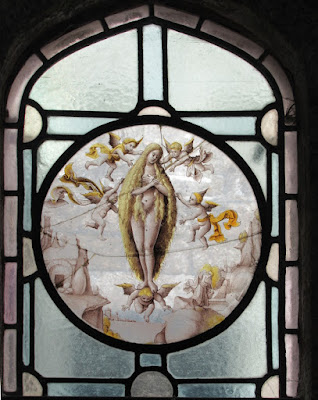One of the main attractions of Cornwall is St. Michaels Mount, a rock on the coast that is supposedly an island, but only at the high tide. It used to be a monastery, from the time of king Henry it has been an aristocratic residence, today it can be visited. Many things are amazing there, one of them are stained glass windows in the dining room. I haven't seen any comment on them so my comment is based entirely on what I see.
One thing I see is that these are not windows that were here when it was the monastery. The monastery was closed during the time of king Henry but some of these windows are clearly baroque, which means they are later. What is more, at least some were not created in England. One of them has an inscription in Dutch, another shows a ship with a Dutch flag (Holland didn't exist at the time of king Henry). Still another shows a pope and a cardinal, which means it wasn't created in the protestant England. One pictures an interior with a window with a stained glass in it but it is a very different window. Some are assembled in a somewhat messy way, for example in one just beneath the main scene one can see a cupid, but aside and without a head, and still lower there are some feet, but upside down.
I am guessing then that it is a collection of an aristocrat put in the present place in the 19th century. At that time it was fashionable among the English aristocrats to bring collections of art from distant countries. Elgin marbles and Benin bronzes are the most famous cases, but they are by no means unique.
Most of the stained glass presented here are not mosaics of coloured glass, as in the mediaeval cathedrals, but scenes painted on a pane with a substance which after baking it became a part of glass. The most common colours are grey and yellow.








No comments:
Post a Comment